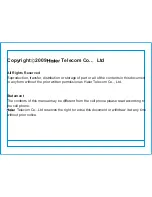
93
DRAFT
regulations for wireless devices
On July 10, 2003, the U.S.
Federal Communications Commission (FCC) Report and Order in WT Docket 01-309 modified the exception of
wireless phones under the Hearing Aid Compatibility Act of 1988 (HAC Act) to require digital wireless phones be
compatible with hearing-aids. The intent of the HAC Act is to ensure reasonable access to telecommunications
services for persons with hearing disabilities.
While some wireless phones are used near some hearing devices (hearing aids and cochlear implants), users
may detect a buzzing, humming, or whining noise. Some hearing devices are more immune than others to this
interference noise, and phones also vary in the amount of interference they generate.
The wireless telephone industry has developed a rating system for wireless phones, to assist hearing device
users to find phones that may be compatible with their hearing devices. Not all phones have been rated. Phones
that are rated have the rating on their box or a label located on the box.
The ratings are not guarantees. Results will vary depending on the user’s hearing device and hearing loss. If your
hearing device happens to be vulnerable to interference, you may not be able to use a rated phone successfully.
Trying out the phone with your hearing device is the best way to evaluate it for your personal needs.
M-Ratings: Phones rated M3 or M4 meet FCC requirements and are likely to generate less interference to hearing
devices than phones that are not labeled. M4 is the better/higher of the two ratings.
Hearing devices may also be rated. Your hearing device manufacturer or hearing health professional may help
you find this rating. Higher ratings mean that the hearing device is relatively immune to interference noise. The
hearing aid and wireless phone rating values are then added together. A sum of 5 is considered acceptable for
normal use. A sum of 6 is considered for best use.
In the example shown, if a hearing aid meets the M2 level rating and the wireless phone meets the M3 level
rating, the sum of the two values equal M5. This should provide the hearing aid user with “normal usage” while
using their hearing aid with the particular wireless phone.
“Normal usage” in this context is defined as a signal quality that’s acceptable for normal operation. The M mark is
intended to be synonymous with the U mark.
The T mark is intended to be synonymous with the UT mark.
The M and T marks are recommended by the Alliance for Telecommunications Industries Solutions (ATIS). The U
and UT marks are referenced in Section 20.19 of the FCC Rules. The HAC rating and measurement procedure
are described in the American National Standards Institute (ANSI) C63.19 standard.
When you’re talking over the cell phone, it’s recommended you’d turn the BT (Bluetooth®) mode off for HAC.
According to HAC policy (NEC Terrain), we state this handset has not been rated for hearing aid compatibility with
respect to the Wi-Fi capability.
This equipment has been tested and found to comply with the limits for a Class B digital device, pursuant to part
15 of the FCC Rules. These limits are designed to provide reasonable protection against harmful interference
in a residential installation. This equipment generates, uses and can radiate radio frequency energy and, if not
installed and used in accordance with the instructions, may cause harmful interference to radio communications.
However, there is no guarantee that interference will not occur in a particular installation. f this equipment does
cause harmful interference to radio or television reception, which can be determined by turning the equipment off
and on, the user is encouraged to try to correct the interference by one or more of the following measures:
• Reorient or relocate the receiving antenna.
• Increase the separation between the equipment and receiver.
• Connect the equipment into an outlet on a circuit different from that to which the receiver is connected.
• Consult the dealer or an experienced radio/TV technician for help.
Note:
The user who makes changes or modifications to the unit without the express approval by the manufacturer will void user authority
to operate the equipment.
Содержание Terrain
Страница 1: ...NEC Terrain User Guide ...





































